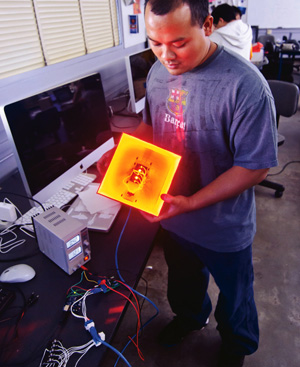THESE DAYS, Room 237 in the Art Building at SJSU is part mad scientist’s workshop, part Macintosh training laboratory and part French postmodern philosophy applied to TCP/IP protocol.
Just one outpost of many making up the CADRE Laboratory for New Media, the room lures me in so I can observe a few dozen folks working on the LiteWall, a.k.a. the Great Temporary Wall of Silicon Valley, a collaborative project by CADRE students and alumni, to be installed for the ZERO1 Biennial this weekend.
For about 25 years now, CADRE has attracted academic outcasts and intellectual refugees from just about every other department, whose creative talents prevent them from functioning within specific disciplines. These are people who operate on the routes between the academic subjects.
During the 1990s, for example, seemingly everything went down in these rooms: computer animation classes, research in data mapping, landscape painting as countersurveillance, experimental video, telepresence or interactive Palm Pilot projects, back when those devices were brand new.
You’d see undergrads sleeping in the labs, while SGI machines rendered their animations all night long, right alongside visiting European grad students drinking and discussing the art of war in the age of intelligent machines. CADRE was place for any technologically inclined creative type who didn’t fit in anywhere else.
Nowadays, the numbers have dwindled, but the academic outlaw spirit still remains. As I walk in, the aroma of burning solder fills the room. Pieces of old projects and fabricated installations sit piled up in one corner. Slick 24-inch Macintosh monitors and their respective keyboards occupy tables against each wall.
Behind one glass case, almost museumlike, I see several PC power supplies. Flyers from old student exhibitions and projects hang everywhere. On a whiteboard, instructional scribbles from dry-erase markers explain pixel dimensions, audio sampling rates and how to convert floats to integers in C. On a side door, I see a faded sticker for DoWhatDo, a gargantuan performance/spectacle that Joel Slayton staged on the roof of the San Pedro Street Garage exactly 20 years ago.
As I observe, a few dozen students and alumni are here working on the LiteWall for the ZERO1 Biennial. That is, each person is constructing his or her own 7-inch-square LED cube, which will fit into a giant grid. Each box is made of Russian birch wood; the sides fit together in dovetail joints; and inside each cube, once completed, there are an LED board and a driver board to monitor the current that operates the LED dimming, brightness and color. Everything is controlled via Ethernet, through a CAT-5 connector that gets wired to the circuit. The participants are given the prefab circuit boards, but they have to solder everything, glue the cubes and assemble the electronic parts themselves. Each cube functions as a giant ‘pixel’ in the final construction of the wall, with each box emitting LEDs whose colors are changeable via Ethernet.
Philips Electronics donated the LEDs, while students came up with the design and the Arduino programming to make the whole thing work. In this way, the whole wall is a giant record of all those who collaborated to build it, a celebration of do-it-yourself culture and a closing of the gap between unknown electronics makers and the consumers who use their products.
In addition, everyone who contributes one of the box/pixels also stamps an electronic message that goes along with it. Via a website, he or she answers questions related to the Biennial theme, “Seeking Silicon Valley.” During the final installation and viewing, any contributor’s pixel can be called up from a controller workstation and everyone will then see the answers each person gave to the questions, in lights, crawling across the entire wall. Thus, each pixel corresponds to a specific contributor, in a self-referencing fashion. And since each participant seeks Silicon Valley in a different manner, a variety of interpretations are there for all to see.
The following night finds me at TechShop, where a repeat workshop unfolds. Even more students and alumni are participating. Some are making multiple boxes. The final wall will be displayed during the (e)MERGE Street Festival, Saturday, 11am-6pm, in the SoFA District.




